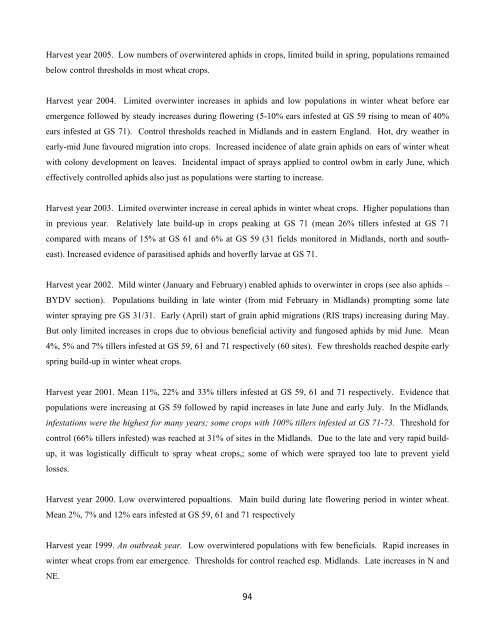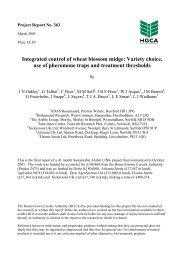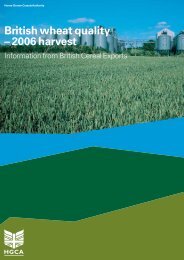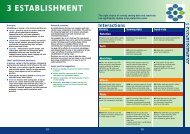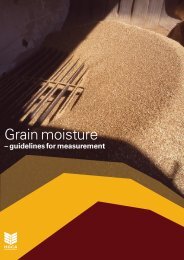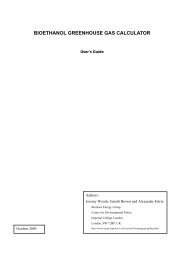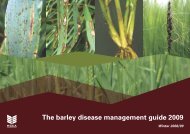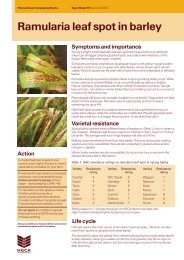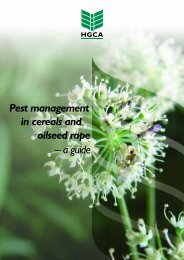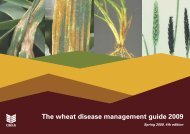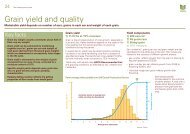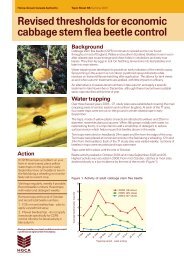Importance of arthropod pests and their natural enemies - HGCA
Importance of arthropod pests and their natural enemies - HGCA
Importance of arthropod pests and their natural enemies - HGCA
You also want an ePaper? Increase the reach of your titles
YUMPU automatically turns print PDFs into web optimized ePapers that Google loves.
Harvest year 2005. Low numbers <strong>of</strong> overwintered aphids in crops, limited build in spring, populations remainedbelow control thresholds in most wheat crops.Harvest year 2004. Limited overwinter increases in aphids <strong>and</strong> low populations in winter wheat before earemergence followed by steady increases during flowering (5-10% ears infested at GS 59 rising to mean <strong>of</strong> 40%ears infested at GS 71). Control thresholds reached in Midl<strong>and</strong>s <strong>and</strong> in eastern Engl<strong>and</strong>. Hot, dry weather inearly-mid June favoured migration into crops. Increased incidence <strong>of</strong> alate grain aphids on ears <strong>of</strong> winter wheatwith colony development on leaves. Incidental impact <strong>of</strong> sprays applied to control owbm in early June, whicheffectively controlled aphids also just as populations were starting to increase.Harvest year 2003. Limited overwinter increase in cereal aphids in winter wheat crops. Higher populations thanin previous year. Relatively late build-up in crops peaking at GS 71 (mean 26% tillers infested at GS 71compared with means <strong>of</strong> 15% at GS 61 <strong>and</strong> 6% at GS 59 (31 fields monitored in Midl<strong>and</strong>s, north <strong>and</strong> southeast).Increased evidence <strong>of</strong> parasitised aphids <strong>and</strong> hoverfly larvae at GS 71.Harvest year 2002. Mild winter (January <strong>and</strong> February) enabled aphids to overwinter in crops (see also aphids –BYDV section). Populations building in late winter (from mid February in Midl<strong>and</strong>s) prompting some latewinter spraying pre GS 31/31. Early (April) start <strong>of</strong> grain aphid migrations (RIS traps) increasing during May.But only limited increases in crops due to obvious beneficial activity <strong>and</strong> fungosed aphids by mid June. Mean4%, 5% <strong>and</strong> 7% tillers infested at GS 59, 61 <strong>and</strong> 71 respectively (60 sites). Few thresholds reached despite earlyspring build-up in winter wheat crops.Harvest year 2001. Mean 11%, 22% <strong>and</strong> 33% tillers infested at GS 59, 61 <strong>and</strong> 71 respectively. Evidence thatpopulations were increasing at GS 59 followed by rapid increases in late June <strong>and</strong> early July. In the Midl<strong>and</strong>s,infestations were the highest for many years; some crops with 100% tillers infested at GS 71-73. Threshold forcontrol (66% tillers infested) was reached at 31% <strong>of</strong> sites in the Midl<strong>and</strong>s. Due to the late <strong>and</strong> very rapid buildup,it was logistically difficult to spray wheat crops,; some <strong>of</strong> which were sprayed too late to prevent yieldlosses.Harvest year 2000. Low overwintered popualtions. Main build during late flowering period in winter wheat.Mean 2%, 7% <strong>and</strong> 12% ears infested at GS 59, 61 <strong>and</strong> 71 respectivelyHarvest year 1999. An outbreak year. Low overwintered populations with few beneficials. Rapid increases inwinter wheat crops from ear emergence. Thresholds for control reached esp. Midl<strong>and</strong>s. Late increases in N <strong>and</strong>NE.94


